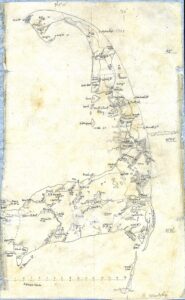Around the time of the millennium I lived on Cape Cod in Provincetown, in my girlfriend’s house, and I was glad to be back in my native state after twenty years in New York. Provincetown was the part of uptight Massachusetts I could bear because of the art and the landscape and the queerness. I began to devour everything I could about this new place that was also old in my life. I read that Thoreau had taken this walk from Eastham, which is roughly the elbow of the cape, to the wrist, which is Truro, and finally to the fist or the hand, which is Provincetown, the pointing finger, where I lived. I began assailing everyone I wrote for at the time, which was mainly Art in America and the Voice to let me write a piece about this walk, but no dice. It was the corny kind of piece that Cape Cod magazines ran from time to time or the Times in their leisure section — it was something nice. Thoreau was not nice, and I went ahead and did the walk anyhow.

I walked in October, which was historically accurate since Thoreau took his first walk then. He had never been to Cape Cod. He took a train to Bridgewater but before he was able to begin his voyage the St. John, a famine boat, crashed in Cohasset. One hundred people from Ireland had journeyed to America and the ship crashed on Grampus Ledge and the bodies of the immigrants were laid out on the beach at Cohasset for their families from all over Boston to claim. I also have a devastation to share but I’m saving mine for later. Thoreau met rain at the beginning of his trip with Channing, an energetic and quirky friend who we never hear much from yet his presence enabled Thoreau’s walk to be more of a mutual condition. When I redid the walk in 2022, I invited Robert Harms, a painter from Long Island, to join me but our dates kept shifting on account of the weather and ultimately I hoofed it alone. I wanted to take the Cross Sound Ferry to New London, and Thoreau also wanted to sail but we both got stormed out and I took a train instead like him and arrived in the charming chaos of Logan where a level of disorder is allowed, even encouraged that struck me as distinctly Irish. And the masses of pouty and chatty people in terminal five were all going to Ireland and some to Cape Cod.
The Provincetown plane was tiny. We get up there and it’s always thrilling. Phones are out. Still Thoreau would have preferred the earth, travelling in the air like a bird taps into the very thing we need to go easy on. Even then it was fuel. From the bowl of the sky I can never bother to try and understand land. For me it puts way too much burden on the experience to start building a map.
In 20 minutes we’re arriving in P’town. It’s very moving and technically in terms of my journey I’m beginning at the end and Thoreau did that too at least once and there’s the Pilgrim Monument to white supremacy right there. That’s what the Pilgrim Monument is, you know. Nobody’s going to pull it down but there are 175 commemorative stones installed in the structure and none reflect the Portuguese community who comprised at least one third of the population by 1910 when the monument was complete (in 1920 the local branch of the Ku Klux Klan put a burning cross in front of the town’s Catholic church) or the Wampanoag tribe who fed the colonists when they first arrived. But as Teddy Roosevelt put it when he laid the cornerstone in 1907, “The puritan’s task was to conquer a continent … and only a master spirit among men could have done it.” So maybe co-celebrating the arrival of the Pilgrims for the Wampanoag would be like Palestinians celebrating Nakba.
For me the important fact about the monument (besides that I hate it) is that it killed an 84-year-old woman who along with a few others was gawking at the bottom of the hill watching a block of granite get pulled by cable car up to the top. A freak storm arose and a bolt of lightning struck the cable and the car came careening right down the hill. Rosilla! someone yelled but Mrs. Rosilla Rich Bangs (who had introduced herself to Teddy Roosevelt at the laying of the cornerstone: I’m the oldest woman in town) apparently froze when she saw what was coming. Currently there’s a funicular being built to shuttle tourists up the hill. It seems to me it’s time to call it the Mrs. Rosilla Rich Bangs funicular, don’t you think?
Excerpted and reprinted with permission from AGNI, Oct. 15, 2022. An expanded version of the essay in book form will be published by Neck Press with images by Cole Barash in 2024.



